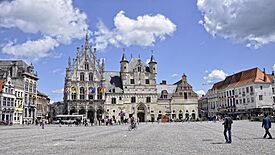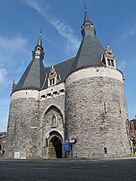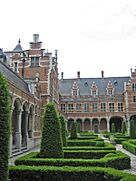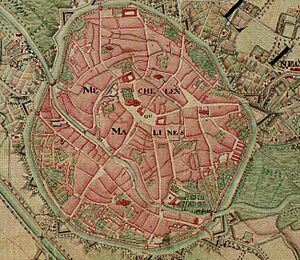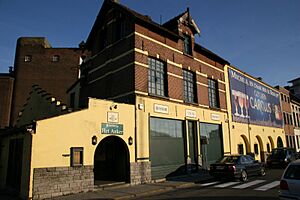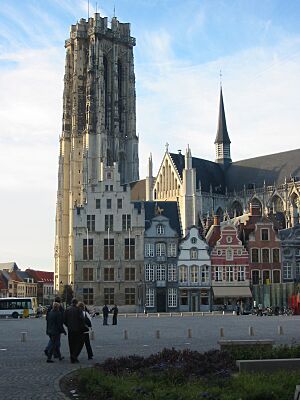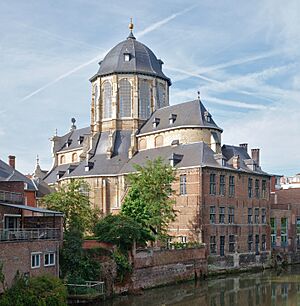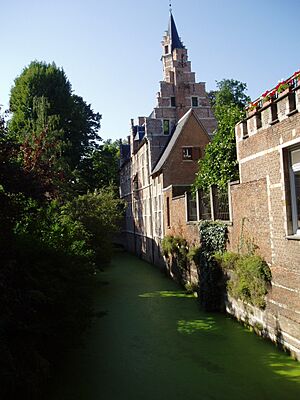Mechelen facts for kids
Quick facts for kids
Mechelen
Malines (French)
|
|||
|---|---|---|---|
|
Left to right, top to bottom: View of the city with St. Rumbold's Cathedral on the far left, Grote Markt with Mechelen City Hall, Brusselpoort, Hof van Savoye, IJzerenleen in the city center with the Schepenhuis
|
|||
|
|||
| Country | Belgium | ||
| Community | Flemish Community | ||
| Region | Flemish Region | ||
| Province | Antwerp | ||
| Arrondissement | Mechelen | ||
| Area | |||
| • Total | 33.71 km2 (13.02 sq mi) | ||
| Population
(2018-01-01)Lua error in Module:Wd at line 1575: attempt to index field 'wikibase' (a nil value).
|
|||
| • Total | Lua error in Module:Wd at line 1,575: attempt to index field 'wikibase' (a nil value). | ||
| Postal codes |
2800, 2801, 2811, 2812
|
||
| Area codes | 015–03 | ||
Mechelen is a vibrant city and municipality in the Antwerp province of Belgium. It's part of the Flemish Region, where people speak Dutch. The city is often called the Dijlestad because the Dyle river flows right through it.
Mechelen is located about 25 kilometers from both Brussels and Antwerp. This makes it a great place for people to live and work. Many residents work in Mechelen's own industries or offices. Others commute to Brussels or Antwerp's seaport.
Mechelen is also famous for its rich history and art. It's one of the most important historical art cities in Flanders. During the Northern Renaissance, many talented artists came here. Painters, printmakers, and musicians found support from important people like Margaret of Austria.
Contents
Mechelen: A City Through Time
How Did Mechelen Begin?
Archaeologists have found signs of people living here a very long time ago. They discovered an 8.4-meter-long canoe and wooden houses near Nekkerspoel. This shows that people lived in the wetlands around Mechelen.
Later, during the Gallo-Roman period, people settled along the Dyle river. After the Roman Empire declined, Germanic tribes moved in. Around the 7th century, the area became Christian. It's believed that St Rumbold, a missionary, helped with this. He is also said to have built a monastery. The famous St. Rumbold's Cathedral was started around the year 1200.
In 1303, Mechelen gained special trading rights from John II, Duke of Brabant. This meant it became a major trading center for wool, oats, and salt. This made Mechelen very wealthy and powerful. It also started a long-lasting rivalry with the city of Antwerp.
Mechelen's Golden Age (15th–18th Centuries)

In the 15th century, the Dukes of Burgundy took control of Mechelen. This period brought a lot of prosperity to the city. In 1473, Charles the Bold moved important government offices here. Mechelen became the home of the Superior Court until the French Revolution. A postal service connecting Mechelen and Innsbruck also started in 1490.
The city's cloth trade was very profitable. This helped Mechelen become the capital of the Low Countries (which included modern-day Netherlands, Belgium, and Luxembourg) in the early 1500s. This happened when Archduchess Margaret of Austria was in charge.
However, Mechelen's political power began to decrease in the 16th century. Many government offices moved to Brussels in 1530. Also, a gunpowder storage explosion in 1546 caused a lot of damage. To make up for this, Mechelen became more important in religious matters. In 1559, it was made the Archdiocese of Mechelen. This meant it was the main religious center for the area that would become Belgium. Today, it's called the Archdiocese of Mechelen–Brussels.
The Great Council of Mechelen remained the highest court until the French Revolutionary Wars. In 1572, during the Eighty Years' War, Spanish soldiers attacked and looted the city. This event is known as the Spanish Fury at Mechelen. The city was rebuilt, but then looted again in 1580 during the English Fury at Mechelen. It was around this time that the city's tradition of furniture making began.
In 1781, Joseph II, Holy Roman Emperor, ordered the city's strong walls to be torn down. Today, the area where the walls once stood is now an inner ring road.
Mechelen in Modern Times
The 19th century brought the industrial age to Mechelen. In 1835, the very first railway on the European continent connected Brussels with Mechelen. This made Mechelen a central point for Belgium's railway system. Because of this, metalworking industries grew, including large railway workshops that are still in the city today.
During World War II, Mechelen's railway system was used by the Nazi forces. They set up a transit camp here. From this camp, over 25,000 Jews and Roma were sent by train to the Auschwitz-Birkenau camp. Today, the site of the transit camp is home to the Kazerne Dossin Memorial, Museum and Documentation Centre on Holocaust and Human Rights. This museum teaches about the Holocaust and human rights.
Mechelen has also been important for Christian religious meetings. From 1921 to 1925, special meetings called the Malines Conversations took place. These talks aimed to bring the Anglican and Roman Catholic Churches closer together.
Fun Facts and Traditions
Why are Mechelen's People Called "Moon Extinguishers"?
Most cities in Flanders have a funny nickname for their residents. Since 1687, people from Mechelen have been called Maneblussers (moon extinguishers). This name comes from a story about a heroic attempt to fight a "fire" high up in the Saint-Rumbold's Tower. It turned out the "fire" was just the moon shining through the gothic windows!
The Ommegang Parade
Every 25 years, Mechelen holds a special parade called the Ommegang. This parade celebrates important moments in the city's past. It remembers the arrival of Emperor Maximilian I and other big events. The Ommegang features six huge 15th–17th-century processional giants. These are giant puppets and carts, all made on a very large scale. Since 2005, this parade has been recognized by UNESCO as a Masterpiece of the Oral and Intangible Heritage of Humanity.
The city's 17th-century wooden mascot is called Opsinjoorke. This doll is pulled around on a sheet during the Ommegang. There's even a bronze statue of the Opsinjoorke in front of the Belfry today.
Local Language
Many people from Mechelen speak a special Dutch dialect called Mechlinian (Mechels). It's different from other dialects spoken in the Brabantic region. There's even a quarterly magazine called De Mecheleir that shows old photos and stories about local history. Some columns in the magazine are written to sound like the dialect.
What Mechelen is Known For
Mechelen has a long history of skilled trades. These include making woollen cloth (laken), tapestries, and fine Mechlin lace. The city is also known for its beautiful wood carving and furniture.
Mechelen is a global center for the carillon, which is a musical instrument made of bells. The main school for carillon players in the world is located here.
The area around Mechelen is famous for growing vegetables. Some popular ones are Belgian endive (witloof), asparagus, and cauliflower. The Mechelse Veilingen nearby is the largest vegetable auction in Europe.
Mechelen also has its own special animal breeds. The Malinois is one of the four breeds of Belgian Sheepdogs. The Mechelse koekoek is a local chicken breed. These chickens have black and white feathers, like a cuckoo bird.
The city is also known for its beer. Mechelsen Bruynen was supposedly the favorite beer of Emperor Charles V. A version of this beer is still brewed today at the Het Anker brewery, one of Belgium's oldest breweries.
Mechelen's Weather
Mechelen has an oceanic climate, which means it has mild temperatures. Summers are warm, and winters usually stay above freezing. The weather is often cloudy, and it rains frequently, but usually not too heavily.
| Climate data for Mechelen (1981–2010 normals, sunshine 1984–2013) | |||||||||||||
|---|---|---|---|---|---|---|---|---|---|---|---|---|---|
| Month | Jan | Feb | Mar | Apr | May | Jun | Jul | Aug | Sep | Oct | Nov | Dec | Year |
| Mean daily maximum °C (°F) | 6.2 (43.2) |
7.0 (44.6) |
10.8 (51.4) |
14.5 (58.1) |
18.5 (65.3) |
21.1 (70.0) |
23.4 (74.1) |
23.2 (73.8) |
19.7 (67.5) |
15.3 (59.5) |
10.1 (50.2) |
6.5 (43.7) |
14.7 (58.5) |
| Daily mean °C (°F) | 3.5 (38.3) |
3.7 (38.7) |
6.8 (44.2) |
9.6 (49.3) |
13.7 (56.7) |
16.4 (61.5) |
18.6 (65.5) |
18.2 (64.8) |
15.0 (59.0) |
11.3 (52.3) |
7.0 (44.6) |
4.0 (39.2) |
10.6 (51.1) |
| Mean daily minimum °C (°F) | 0.8 (33.4) |
0.6 (33.1) |
3.0 (37.4) |
4.8 (40.6) |
8.8 (47.8) |
11.6 (52.9) |
13.8 (56.8) |
13.2 (55.8) |
10.5 (50.9) |
7.4 (45.3) |
4.1 (39.4) |
1.6 (34.9) |
6.7 (44.1) |
| Average precipitation mm (inches) | 69.0 (2.72) |
57.5 (2.26) |
64.8 (2.55) |
46.5 (1.83) |
62.0 (2.44) |
72.7 (2.86) |
75.5 (2.97) |
71.8 (2.83) |
70.9 (2.79) |
71.9 (2.83) |
74.4 (2.93) |
75.3 (2.96) |
812.4 (31.98) |
| Average precipitation days | 12.4 | 10.7 | 12.2 | 9.4 | 10.8 | 10.4 | 10.0 | 9.7 | 10.3 | 11.2 | 12.4 | 12.6 | 132.0 |
| Mean monthly sunshine hours | 58 | 77 | 122 | 174 | 207 | 202 | 212 | 201 | 145 | 118 | 64 | 48 | 1,627 |
| Source: Royal Meteorological Institute | |||||||||||||
Sports in Mechelen
Mechelen is home to two old Belgian football clubs, both founded in 1904: K.R.C. Mechelen and K.V. Mechelen. K.V. Mechelen even won the UEFA Cup Winners' Cup and the European Super Cup in 1988! This brought international fame to the city. Many smaller local teams also show how popular football is here.
The city also has a rugby union club called Mechelen RFC. If you like Ultimate frisbee, there's a club called Freespect in Mechelen too. In 1985, Mechelen hosted the Canoe Sprint World Championships.
What to See in Mechelen
Mechelen has many important cathedrals and churches. The most famous is St. Rumbold's Cathedral, with its huge tower. This tower was finished in 1312 and is a UNESCO World Heritage Site. The Basilica of Our Lady of Hanswijk is a beautiful domed church. It's a famous place for pilgrimages in Belgium. The Church of Our Lady across the Dijle and the Sint-Janskerk display artworks by the famous painter Rubens.
Other religious buildings include the Palace of the Archbishop of Mechelen-Brussels. The Small and Large Beguinages are also here. These are special communities where religious women live. They are also part of a World Heritage Site.
The Lakenhal (a cloth hall) and the 14th-century Belfry are now part of the modern City Hall. This hall and belfry are also a World Heritage Site because of their importance to the city.
The Brusselpoort is the last remaining city gate from the 13th century. The Schepenhuis is the oldest stone city hall in Flanders. It used to be the home of the Supreme Court. The Hof van Busleyden, a beautiful gothic-renaissance building, now houses the City Museum. The Vismarkt is a 16th-century square by the Dijle river.
Many famous people lived in Mechelen centuries ago, and their houses are still here. The Hof van Savoye was built for Margaret of Austria. She was the regent of the Netherlands and raised Charles V here. It's one of the first Renaissance buildings north of the Alps.
Mechelen also has many museums, parks, and even a zoo:
- The Jewish Museum of Deportation and Resistance is in a building that was once a transit camp.
- Technopolis is a fun center for hands-on science and technology.
- The Mechelen Toy Museum is located at Nekkerspoel.
- Planckendael Zoo is in Muizen.
- The Botanical Garden of Mechelen (Kruidtuin) is a city park with a statue of the 16th-century botanist Rembert Dodoens.
- The Royal Carillon School "Jef Denyn" is where people from all over the world come to learn how to play the carillon.
Other interesting sights include 't Groen Waterke, a small, pretty remnant of old canals. There's also a stone pillar called De Mijlpaal in front of the station. It marks the spot where the first passenger train ride on the continent ended.
Mechelen has over 300 protected historical monuments!
City Safety and Police
Mechelen uses special cameras called ANPR cameras. Since 2011, these cameras check all cars entering and leaving the city. They compare car license plates to a database of stolen cars or cars listed for other reasons. If there's a match, the police are alerted so they can quickly stop the car. Mechelen was one of the first cities in Belgium to use this system on such a large scale.
Mechelen and Willebroek joined their local police forces in 2015. Since 2023, the police zone also includes Puurs-Sint-Amands and Bornem. It is now called the Rivierenland Police Zone.
People of Mechelen
Mechelen is a very diverse city with people from over 100 different countries. A significant part of the community is of Moroccan origin.
| Group of origin | Year | |
|---|---|---|
| 2023 | ||
| Number | % | |
| Belgians with Belgian background | 55,473 | 62.6% |
| Belgians with foreign background | 22,216 | 25.07% |
| Neighboring country | 2,025 | 2.29% |
| EU27 (excluding neighboring country) | 1,340 | 1.51% |
| Outside EU 27 | 18,851 | 21.27% |
| Non-Belgians | 10,925 | 12.33% |
| Neighboring country | 1,406 | 1.59% |
| EU27 (excluding neighboring country) | 2,165 | 2.44% |
| Outside EU 27 | 7,354 | 8.3% |
| Total | 88,614 | 100% |
Famous People from Mechelen
Many notable people have connections to Mechelen:
- Margaret of York (1446–1503): Duchess of Burgundy. She educated several children who later became queens in Europe.
- Margaret of Austria (1480–1530): Regent of the Netherlands and guardian of Charles V.
- Charles V, Holy Roman Emperor (1500–1558): He grew up in Mechelen until he was 17.
- Anne Boleyn (1504–1536): Future wife of English King Henry VIII.
- Rembert Dodoens (1517–1585): A famous botanist and physician.
- Philippe de Monte (1521–1603): A Renaissance composer.
- Rik Wouters (1882–1916): A talented painter and sculptor.
- Lodewijk van Beethoven (1712–73): The grandfather of the famous composer Ludwig van Beethoven.
- Adèle Colson (1905–1997): The first woman in the world to earn a carillon certification.
- Bart Somers (b. 1964): The current mayor who won the World Mayor Prize in 2016.
Mechelen's Sister Cities
Mechelen has sister cities around the world. These partnerships help build friendships and understanding between different cultures:
 Sucre, Bolivia
Sucre, Bolivia Dijon, France
Dijon, France Yūki, Japan (since 1996)
Yūki, Japan (since 1996) Helmond, Netherlands
Helmond, Netherlands Sibiu, Romania
Sibiu, Romania Arvada, U.S.
Arvada, U.S.
Images for kids
See also
 In Spanish: Malinas para niños
In Spanish: Malinas para niños



